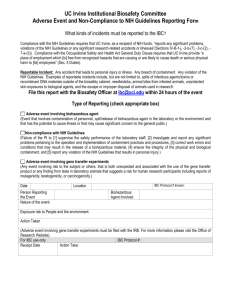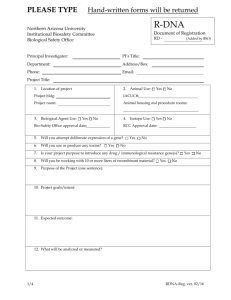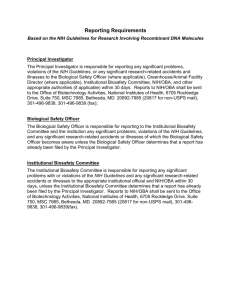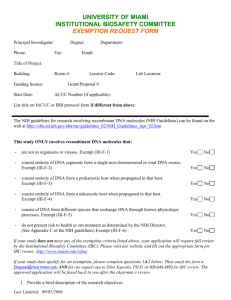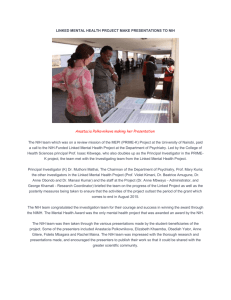Guidelines for Gene Transfer Protocols
advertisement
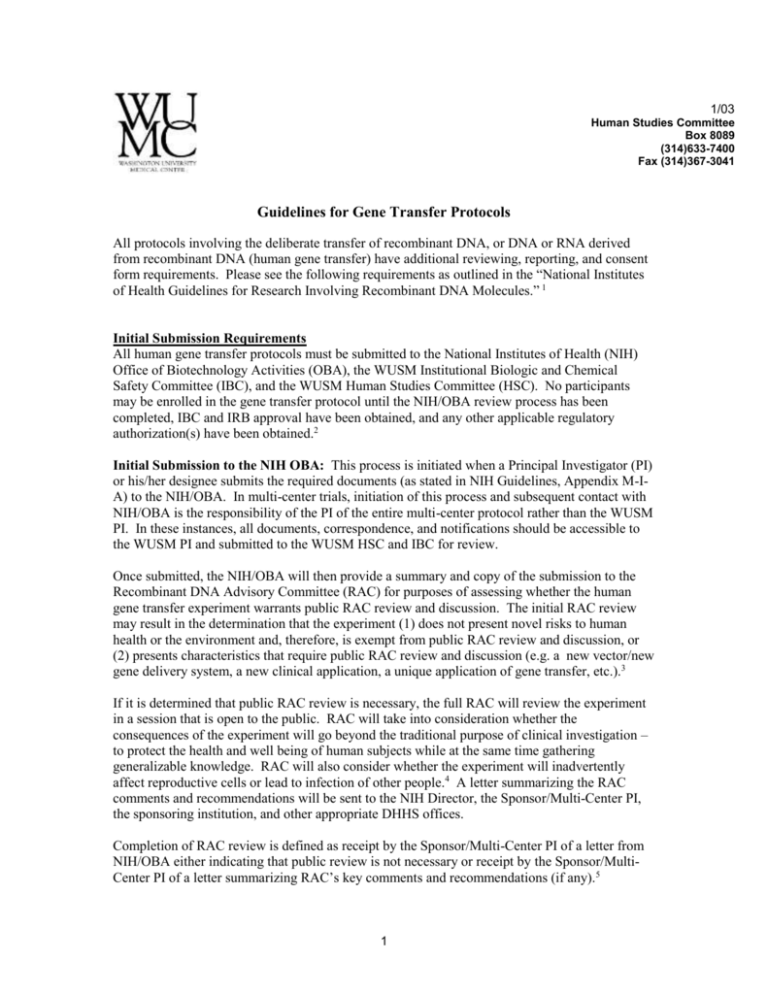
1/03 Human Studies Committee Box 8089 (314)633-7400 Fax (314)367-3041 Guidelines for Gene Transfer Protocols All protocols involving the deliberate transfer of recombinant DNA, or DNA or RNA derived from recombinant DNA (human gene transfer) have additional reviewing, reporting, and consent form requirements. Please see the following requirements as outlined in the “National Institutes of Health Guidelines for Research Involving Recombinant DNA Molecules.” 1 Initial Submission Requirements All human gene transfer protocols must be submitted to the National Institutes of Health (NIH) Office of Biotechnology Activities (OBA), the WUSM Institutional Biologic and Chemical Safety Committee (IBC), and the WUSM Human Studies Committee (HSC). No participants may be enrolled in the gene transfer protocol until the NIH/OBA review process has been completed, IBC and IRB approval have been obtained, and any other applicable regulatory authorization(s) have been obtained.2 Initial Submission to the NIH OBA: This process is initiated when a Principal Investigator (PI) or his/her designee submits the required documents (as stated in NIH Guidelines, Appendix M-IA) to the NIH/OBA. In multi-center trials, initiation of this process and subsequent contact with NIH/OBA is the responsibility of the PI of the entire multi-center protocol rather than the WUSM PI. In these instances, all documents, correspondence, and notifications should be accessible to the WUSM PI and submitted to the WUSM HSC and IBC for review. Once submitted, the NIH/OBA will then provide a summary and copy of the submission to the Recombinant DNA Advisory Committee (RAC) for purposes of assessing whether the human gene transfer experiment warrants public RAC review and discussion. The initial RAC review may result in the determination that the experiment (1) does not present novel risks to human health or the environment and, therefore, is exempt from public RAC review and discussion, or (2) presents characteristics that require public RAC review and discussion (e.g. a new vector/new gene delivery system, a new clinical application, a unique application of gene transfer, etc.).3 If it is determined that public RAC review is necessary, the full RAC will review the experiment in a session that is open to the public. RAC will take into consideration whether the consequences of the experiment will go beyond the traditional purpose of clinical investigation – to protect the health and well being of human subjects while at the same time gathering generalizable knowledge. RAC will also consider whether the experiment will inadvertently affect reproductive cells or lead to infection of other people.4 A letter summarizing the RAC comments and recommendations will be sent to the NIH Director, the Sponsor/Multi-Center PI, the sponsoring institution, and other appropriate DHHS offices. Completion of RAC review is defined as receipt by the Sponsor/Multi-Center PI of a letter from NIH/OBA either indicating that public review is not necessary or receipt by the Sponsor/MultiCenter PI of a letter summarizing RAC’s key comments and recommendations (if any).5 1 Initial Submission to the IBC: Please see WUSM IBC submission forms at (insert). All gene transfer protocols shall be reviewed and approved by the IBC. IBC approval will be documented in the form of an approval letter. IBC and HSC will conduct simultaneous review. Initial Submission to the HSC: In addition to general submission requirements, the HSC will hold final approval and release for subject accrual on receipt of documentation of the outcome of submission to NIH/OBA and IBC approval. A copy of the completed Appendix M should be submitted to the HSC. Subsequent Submission Requirements All reviewing bodies (NIH/OBA, IBC, and the HSC) require subsequent reports following the initial review and/or approval. This includes requests for review of revisions to the protocol6, safety reports, and renewal paperwork7. Additional requirements for gene transfer protocols are as follows: NIH OBA Reporting Requirements: No later than 20 working days after following enrollment of the first research participant, all documents listed in Appendix M-I-C-1 must be submitted to the NIH/OBA. If a clinical site is added to the protocol, no participants may be enrolled until the documents listed in Appendix M-I-C-2 have been submitted to the NIH OBA. The Sponsor/Multi-Center PI (or designee) is required to submit the documents and updates requested in appendix M-I-C-3 (a-c) within 60 days of the one-year anniversary of the date on which the IND application went into effect and after each subsequent anniversary until the trial is completed. The Sponsor/Multi-Center PIs (or designees) must submit a written report to NIH/OBA for all serious adverse events (SAEs) that are both unexpected and associated with the use of the gene transfer product and for any findings from tests in laboratory animals that suggest a significant risk for human research participants including reports of mutagenicity, teratogenicity, or carcinogenicity. The specific requirements for the NIH/OBA safety report are listed in Appendix M-I-C-4-a. SAEs that are fatal or life-threatening, unexpected, and associated with the gene transfer product must be reproted to NIH OBA as soon as posisble but no later than seven calender days after the sponsor’s initial receipt of the information. All other SAEs that are associated with the use of the gene transfer product but are not fatal or life-threatenting, follow-up infomration that is relevent to a SAE, and findings from tests in laboratory animals that suggest a significant risk for participants must be reported to NIH/OBA as soon as possible, but no later than 15 calender days after the sponsor’s initial receipt of the information.8 WUSM IBC Reporting Requirements: In accordance with NIH/OBA requirements, a copy of all SAEs should be submitted to the IBC for review and documentation. PIs should simultaneously submit SAEs to the IBC and the IRB. A copy of all revision/amendments related to the gene transfer product and the HSC renewal paperwork should be sent to the IBC for review and acknowledgement or approval (as appropriate). HSC and IBC will conduct simultaneous review. HSC Reporting Requirements: Gene transfer protocols must meet the standard HSC reporting requirements for SAEs, revision/amendments, and renewals. In addition, the HSC requires that the PI submit documentation of adherence with the NIH/OBA and IBC reporting requirements for 2 SAEs and annual reports (a copy of the annual report should be submitted with the renewal paperwork). Please note that HSC approval of SAEs, renewals, and revision/amendments related to the gene transfer protocol will be contingent upon IBC review. Consent Form Requirements9 Due to the novelty of the procedures that are used in gene transfer protocols, the potentially irreversible consequences of the procedures preformed, and the fact that many of the potential risks remain undefined, the consent form for gene transfer protocols must include the following information in addition to the requirements prescribed in 45 CFR 46.116 and 21 CFR 50.25. (For the required elements of consent and WUSM consent form templates, please see HSC Forms 2 and 3.) Please note that a separate consent form should be used if the gene transfer is used as an adjunct in the study of another technique (e.g. when a gene is used as a “marker” or to enhance the power of immunotherapy for cancer).10 Purpose: The purpose and procedures associated with the gene transfer component of the research should be explained to study participants in 6th to 8th grade language. Risks11: The types, relative severity, and expected frequencies of potential adverse events should be stated in the consent form. Potential adverse events should be categorized as follows: mild (adverse events that do not require a therapeutic intervention), moderate (those that require an intervention), and severe (those that are potentially fatal or life-threatening, disabling, or require prolonged hospitalization). All other verbal descriptors (e.g. rare, uncommon, or frequent) should be explained. The consent form should state the approximate number of people who have previously received the genetic material under study. The consent form should warn potential participants that unforeseen and severe risks are possible for research involving genetic materials previously used in relatively few or no humans. The consent form should also state any potential adverse medical consequences that may occur if the participant withdraws from the study. Reproductive Considerations12: To avoid the possibility that any of the reagents employed in the gene transfer research could cause harm to a fetus/child, the consent form should include information concerning possible risks and the need for contraception by males and females during the active phase of the study. The period of time for the use of contraception should be specified and the inclusion of pregnant or lactating women should be addressed. Benefits13: For studies that are not reasonably expected to provide a therapeutic benefit to participants, the consent form should clearly state that no direct clinical benefit to participants is expected . . . although knowledge may be gained that may benefit others. Alternatives14: The consent form should indicate the availability of therapies and the possibility of other investigational interventions and approaches. Long Term Follow-Up15: To permit evaluation of long-term safety and efficacy of gene transfer, the prospective participants should be informed that they are expected to participate in long-term follow-up that extends beyond the active phase of the study. The consent form should include a list of persons who can be contacted in the event that questions arise during the follow- 3 up period. The PI should require that participants continue to provide a current address and telephone number. Request for Autopsy16: To obtain vital information about the safety and efficacy of gene transfer, participants should be informed that at the time of death, no matter what the cause, permission for an autopsy will be requested of their families. Participants should be asked to advise their families of the request and of its scientific and medical importance. Interest of the media and others in the research17: To alert participants that others may have an interest in the innovative character of the protocol and in the status of the treated participants, the participants should be informed of the following: (i) that the institution and the investigators will make efforts to provide protection from the media in an effort to protect the participants’ privacy, and (ii) that representatives of the applicable Federal agencies (e.g. NIH, FDA), representatives of collaborating institutions, vector supplies, etc. will have access to the participants’ medical records. Additional Requirements for HSC Review of Gene Transfer Protocols In order to ensure that rights and welfare of participants in gene transfer protocols are protected, the NIH Guidelines require that the HSC take special consideration of the following topics. Consent Process18: The HSC will take into consideration the following additional key points when assessing the adequacy of the consent process: - Who will present the study to potential participants? - What measures are in place to avoid any conflicts of interest when the PI is also the treating physician? - How will the details of the research purpose and procedures be presented to potential participants in a way that is understandable? - How long will potential participants have to make the decision regarding participation? - What additional provisions are in place for obtaining assent from pediatric and impaired individuals who are unable to consent for themselves? Privacy19: The HSC will take into consideration the following additional key points when assessing the adequacy of the plan for protection of the privacy of participants and their family members: - What provisions have been made to honor the wishes of the participants regarding whether, when, and how the identity of a participant is publicly disclosed? - What provisions will be made to maintain the confidentiality of research data, at least in cases where data could be linked to individual participants? This Guideline is excerpted and adapted from the “NIH Guidelines for Research Involving Recombinant DNA Molecules (4/2002) hereafter referred to as “NIH Guidelines” 2 NIH Guidelines, Appendix M-I-B-1 3 NIH Guidelines, Appendix M 4 NIH Guidelines, Appendix M 5 NIH Guidelines, Appendix M-I-B-1 6 Please note that all requested modification to the protocol must be approved by the HSC and the IBC (if applicable) prior to implementation. 7 At the time of full board review, the HSC will determine the appropriate review frequency. All protocols will be reviewed at least once annually. 1 4 8 NIH Guidelines, Appendix M-I-C-4 (a-b) NIH Guidelines, Appendix M-III 10 NIH Guidelines, Appendix M-III-B 11 NIH Guidelines, Appendix M-III-B-1-e 12 NIH Guidelines, Appendix M-III-B-2-a 13 NIH Guidelines, Appendix M-III-B-1-d 14 NIH Guidelines, Appendix M-III-B-1-b 15 NIH Guidelines, Appendix M-III-B-2-b 16 NIH Guidelines, Appendix M-III-B-2-c 17 NIH Guidelines, Appendix M-III-B-2-d 18 NIH Guidelines, Appendix M-III-A (1-4) 19 NIH Guidelines, Appendix M-IV and M-V 9 5
